-

人教版新目标初中英语九年级上册It must belong to Carla教案
一、Section A该部分有4个模块。第一模块围绕Whose volleyball is this? 这一话题展开思维( 1a)、听力(1b)、口语( 1c)训练;第二模块围绕上一模块中的话题进行听力( 2a-2b)、口语训练( 2c);第三模块继续围绕前两个模块中的“making inferences”展开训练。训练形式为阅读排序( 3a)和两人问答(3b);第四模块仍就上一话题展开讨论。二、Section B该部分有4个模块。第一模块要求根据图画和所提供的单词写出合理的句子;第二模块在听力( 2a-2b)和分角色口语训练( 2c)的基础上,继续进行“推测”训练; 第三模块围绕“Strange events in Bell Tower neighborhood”这一话题展开阅读( 3a)和写作(3b -3c)训练;第四模块以dream为话题展开小组活动。三、Self Check该部分有3个模块。第一模块以填空形式对所学词汇进行训练;第二模块就8个谚语展开阅读和讨论。

人教版新目标初中英语九年级下册Could you please tell me where the restrooms are教案
Step Ⅰ RevisionCheck homework. Ask a few students to read the article in 3a.Then ask a few students to read their guides.Step Ⅱ Part 1Look at the words in the box. Ask a student to read them. Make sure the students understand the meaning of the words. You are to fill in the blanks with the words. In some cases, students may need to use another form of the word, for example adjusting for tense or subject/ verb agreement.Ask students to fill in the blanks on their own.Check the answers. Step ⅢPart 2Go through the instructions with the class.Look at the example with the students.Ask students what the answer would be.Ask a student to read the question and answer it.Excuse me, could you tell me where the bank is, please?The bank is across the street from the shopping malt.Get students to complete the work in pairs.Check the answers. Ask a few students to read their questions.Step Ⅳ Just for Fun!Ask all the students to read the conversation. Ask: What is funny about this cartoon? Help students to explain. A Martian is a person from the planet Mars.There is no such thing as Martian food on Earth, and the clerk looks silly because he is trying to think of where there is a Martian restaurant.Invite some pairs of students to present this conversation to the rest of the class.Step Ⅴ Summary and HomeworkIn this class, we’ve done much writing practice using the key vocabulary words and the target language presented in this unit. After class, please finish the questions in 2 in your exercise books. Then finish the exercises on pages 47~48 of the workbook as well.The Seventh Period Ⅰ Teaching Aims and Demands1. Knowledge Objects(1) Key Vocabularyimage, adventure, jealousy, hero, crime, journey, brave, no longer, show interest in, take it easy, become interested in, plain looks(2)Text:Grown-ups like cartoons, too.2. Ability Objects(1) Fast-reading to get a general idea of the text.(2) Careful-reading to get the detailed information in the text.
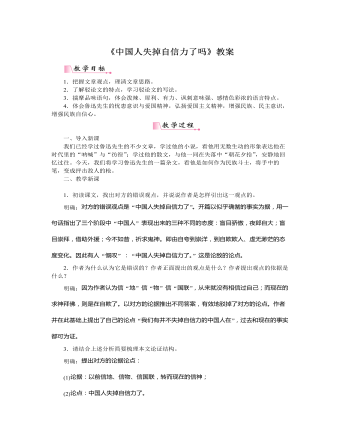
部编版语文九年级上册《中国人失掉自信力了吗》教案
一、导入新课我们已经学过鲁迅先生的不少文章,学过他的小说,看他用无数生动的形象表达他在时代里的“呐喊”与“彷徨”;学过他的散文,与他一同在失落中“朝花夕拾”,安静地回忆过往。今天,我们将学习鲁迅先生的一篇杂文,看他是如何作为民族斗士,将手中的笔,变成抨击敌人的枪。二、教学新课目标导学一:学习驳论,理清思路1.初读课文,找出对方的错误观点,并说说作者是怎样引出这一观点的。明确:对方的错误观点是“中国人失掉自信力了”。开篇以似乎确凿的事实为据,用一句话指出了三个阶段中“中国人”表现出来的三种不同的态度:盲目骄傲,夜郎自大;盲目崇拜,借助外援;今不如昔,祈求鬼神。即由自夸到崇洋,到自欺欺人、虚无渺茫的态度变化。因此有人“慨叹”:“中国人失掉自信力了。”这是论敌的论点。
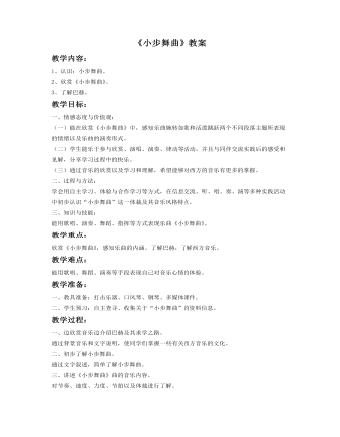
《小步舞曲教案》教案
教学过程:一、边欣赏音乐边介绍巴赫及其求学之路。通过背景音乐和文字说明,使同学们掌握一些有关西方音乐的文化。二、初步了解小步舞曲。通过文字叙述,简单了解小步舞曲。三、讲述《小步舞曲》曲的音乐内容。对节奏、速度、力度、节拍以及体裁进行了解。四、结合谱例分段学习《小步舞曲》。1、学习乐曲A’段。说明:依据乐曲创作背景,合理创设“舞会”情景,从而有效激发学生学习兴趣,用舞蹈表现手段演绎此乐段,发展了学生的舞蹈表演能力,享受到美的愉悦。2、学习乐曲B段。说明:利用形象、直观的图式辅助以及一系列贴近学生思维逻辑的问答讨论,激发学生的思考,帮助学生准确把握乐段情绪,并能用指挥、伴奏等方式表现该乐段。3、完整欣赏《小步舞曲》。说明:学生在完整欣赏乐曲时能够巩固乐曲主题的记忆,并且听辨、感受乐曲两个不同主题情绪,培养学生独立的音乐感受和见解。五、视频欣赏。说明:通过视屏欣赏,使同学们以一个更直观的郊区去理解和学习作品,并使同学对作品有更深刻的记忆。引起学生共鸣,领悟音乐的美感,愉悦身心,获取乐趣,从而激起学习的情趣。
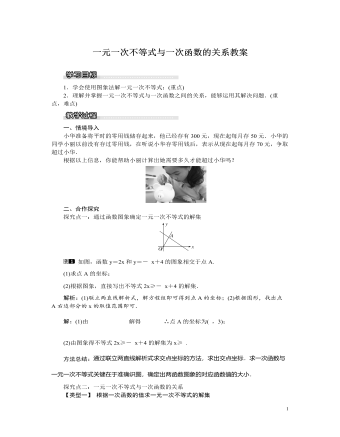
北师大初中八年级数学下册一元一次不等式与一次函数的关系教案
解析:先利用正比例函数解析式确定A点坐标,然后观察函数图象得到,当1<x<2时,直线y=2x都在直线y=kx+b的上方,于是可得到不等式0<kx+b<2x的解集.把A(x,2)代入y=2x得2x=2,解得x=1,则A点坐标为(1,2),∴当x>1时,2x>kx+b.∵函数y=kx+b(k≠0)的图象经过点B(2,0),即不等式0<kx+b<2x的解集为1<x<2.故选C.方法总结:本题考查了一次函数与一元一次不等式的关系:从函数的角度看,就是寻求使一次函数y=ax+b的值大于(或小于)0的自变量x的取值范围;从函数图象的角度看,就是确定直线y=kx+b在y轴上(或下)方部分所有的点的横坐标所构成的集合.三、板书设计1.通过函数图象确定一元一次不等式的解集2.一元一次不等式与一次函数的关系本课时主要是掌握运用一次函数的图象解一元一次不等式,在教学过程中采用讲练结合的方法,让学生充分参与到教学活动中,主动、自主的学习.
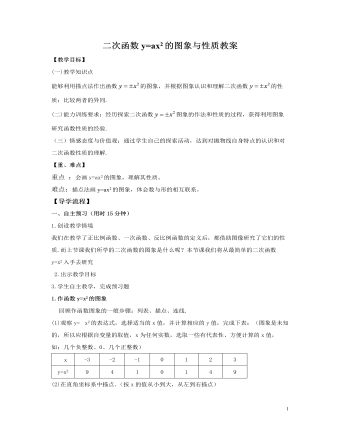
北师大初中九年级数学下册二次函数y=x2和y=-x2的图象与性质2教案
【教学目标】(一)教学知识点能够利用描点法作出函数 的图象,并根据图象认识和理解二次函数 的性质;比较两者的异同.(二)能力训练要求:经历探索二次函数 图象的作法和性质的过程,获得利用图象研究函数性质的经验.(三)情感态度与价值观:通过学生自己的探索活动,达到对抛物线自身特点的认识和对二次函数性质的理解. 【重、难点】重点 :会画y=ax2的图象,理解其性质。难点:描点法画y=ax2的图象,体会数与形的相互联系。 【导学流程】 一、自主预习(用时15分钟)1.创设教学情境我们在教学了正比例函数、一次函数、反比例函数的定义后,都借助图像研究了它们的性质.而上节课我们所学的二次函数的图象是什么呢?本节课我们将从最简单的二次函数y=x2入手去研究

北师大初中八年级数学下册一元一次不等式与一次函数的综合应用教案
解析:(1)根据题设条件,求出等量关系,列一元一次方程即可求解;(2)根据题设中的不等关系列出相应的不等式,通过求解不等式确定最值,求最值时要注意自变量的取值范围.解:设购进A种树苗x棵,则购进B种树苗(17-x)棵,(1)根据题意得80x+60(17-x)=1220,解得x=10,所以17-x=17-10=7,答:购进A种树苗10棵,B种树苗7棵;(2)由题意得17-x172,所需费用为80x+60(17-x)=20x+1020(元),费用最省需x取最小整数9,此时17-x=17-9=8,此时所需费用为20×9+1020=1200(元).答:购买9棵A种树苗,8棵B种树苗的费用最省,此方案所需费用1200元.三、板书设计一元一次不等式与一次函数关系的实际应用分类讨论思想、数形结合思想本课时结合生活中的实例组织学生进行探索,在探索的过程中渗透分类讨论的思想方法,培养学生分析、解决问题的能力,从新课到练习都充分调动了学生的思考能力,为后面的学习打下基础.

北师大初中九年级数学下册二次函数y=ax2+bx+c的图象与性质1教案
解析:(1)已知抛物线解析式y=ax2+bx+0.9,选定抛物线上两点E(1,1.4),B(6,0.9),把坐标代入解析式即可得出a、b的值,继而得出抛物线解析式;(2)求出y=1.575时,对应的x的两个值,从而可确定t的取值范围.解:(1)由题意得点E的坐标为(1,1.4),点B的坐标为(6,0.9),代入y=ax2+bx+0.9,得a+b+0.9=1.4,36a+6b+0.9=0.9,解得a=-0.1,b=0.6.故所求的抛物线的解析式为y=-0.1x2+0.6x+0.9;(2)157.5cm=1.575m,当y=1.575时,-0.1x2+0.6x+0.9=1.575,解得x1=32,x2=92,则t的取值范围为32<t<92.方法总结:解答本题的关键是注意审题,将实际问题转化为求函数问题,培养自己利用数学知识解答实际问题的能力.三、板书设计二次函数y=ax2+bx+c的图象与性质1.二次函数y=ax2+bx+c的图象与性质2.二次函数y=ax2+bx+c的应用

北师大初中九年级数学下册二次函数y=ax2+bx+c的图象与性质2教案
1.使学生掌握用描点法画出函数y=ax2+bx+c的图象。2.使学生掌握用图象或通过配方确定抛物线的开口方向、对称轴和顶点坐标。让学生经历探索二次函数y=ax2+bx+c的图象的开口方向、对称轴和顶点坐标以及性质的过程,理解二次函数y=ax2+bx+c的性质。用描点法画出二次函数y=ax2+bx+c的图象和通过配方确定抛物线的对称轴、顶点坐标理解二次函数y=ax2+bx+c(a≠0)的性质以及它的对称轴(顶点坐标分别是x=-b2a、(-b2a,4ac-b24a)一、提出问题1.你能说出函数y=-4(x-2)2+1图象的开口方向、对称轴和顶点坐标吗?(函数y=-4(x-2)2+1图象的开口向下,对称轴为直线x=2,顶点坐标是(2,1)。2.函数y=-4(x-2)2+1图象与函数y=-4x2的图象有什么关系?(函数y=-4(x-2)2+1的图象可以看成是将函数y=-4x2的图象向右平移2个单位再向上平移1个单位得到的)

北师大初中九年级数学下册二次函数y=a(x-h)2+k的图象与性质1教案
(3)设点A的坐标为(m,0),则点B的坐标为(12-m,0),点C的坐标为(12-m,-16m2+2m),点D的坐标为(m,-16m2+2m).∴“支撑架”总长AD+DC+CB=(-16m2+2m)+(12-2m)+(-16m2+2m)=-13m2+2m+12=-13(m-3)2+15.∵此二次函数的图象开口向下,∴当m=3米时,“支撑架”的总长有最大值为15米.方法总结:解决本题的关键是根据图形特点选取一个合适的参数表示它们,得出关系式后运用函数性质来解.三、板书设计二次函数y=a(x-h)2+k的图象与性质1.二次函数y=a(x-h)2+k的图象与性质2.二次函数y=a(x-h)2+k的图象与y=ax2的图象的关系3.二次函数y=a(x-h)2+k的应用要使课堂真正成为学生展示自我的舞台,还学生课堂学习的主体地位,教师要把激发学生学习热情和提高学生学习能力放在教学首位,为学生提供展示自己聪明才智的机会,使课堂真正成为学生展示自我的舞台.充分利用合作交流的形式,能使教师发现学生分析问题、解决问题的独到见解以及思维的误区,以便指导今后的教学.

北师大初中九年级数学下册二次函数y=x2和y=-x2的图象与性质1教案
雨后天空的彩虹、河上架起的拱桥等都会形成一条曲线.问题1:这些曲线能否用函数关系式表示?问题2:如何画出这样的函数图象?二、合作探究探究点:二次函数y=x2和y=-x2的图象与性质【类型一】 二次函数y=x2和y=-x2的图象的画法及特点在同一平面直角坐标系中,画出下列函数的图象:(1)y=x2;(2)y=-x2.根据图象分别说出抛物线(1)(2)的对称轴、顶点坐标、开口方向及最高(低)点坐标.解析:利用列表、描点、连线的方法作出两个函数的图象即可.解:列表如下:x y) -2 -1 0 1 2y=x2 4 1 0 1 4 y=-x2 -4 -1 0 -1 -4 描点、连线可得图象如下:(1)抛物线y=x2的对称轴为y轴,顶点坐标为(0,0),开口方向向上,最低点坐标为(0,0);(2)抛物线y=-x2的对称轴为y轴,顶点坐标为(0,0),开口方向向下,最高点坐标为(0,0).方法总结:画抛物线y=x2和y=-x2的图象时,还可以根据它的对称性,先用描点法描出抛物线的一侧,再利用对称性画另一侧.

北师大初中九年级数学下册二次函数y=ax2和y=ax2+c的图象与性质1教案
变式训练:见《学练优》本课时练习“课堂达标训练”第5题【类型二】 在同一坐标系中判断二次函数和一次函数的图象在同一直角坐标系中,一次函数y=ax+c和二次函数y=ax2+c的图象大致为()解析:∵一次函数和二次函数都经过y轴上的点(0,c),∴两个函数图象交于y轴上的同一点,故B选项错误;当a>0时,二次函数的图象开口向上,一次函数的图象从左向右上升,故C选项错误;当a<0时,二次函数的图象开口向下,一次函数的图象从左向右下降,故A选项错误,D选项正确.故选D.方法总结:熟记一次函数y=kx+b在不同情况下所在的象限,以及熟练掌握二次函数的有关性质(开口方向、对称轴、顶点坐标等)是解决问题的关键.变式训练:见《学练优》本课时练习“课后巩固提升” 第4题【类型三】 二次函数y=ax2+c的图象与三角形的综合

中班主题课件教案:“我的朋友”的主题反思
主题目标: 能关注周围环境中的事物,初步了解并体验人与人、人与整个环境和谐相处的快乐感觉;能在成人帮助下逐步形成与他人共处的良好态度;学习并尝试与人交往的方式,促进社会交往能力的发展。 主题的开展: 本月以“我的朋友”为主题,围绕“朋友都有谁、快快乐乐来玩耍、友好相处是朋友、”三个方面的内容展开活动,环境方面突出的是我们有效的利用家长资源,带动幼儿及教师家长的兴趣。 俗话说:“有朋自远方来”孩子年龄随小,但他们也在逐渐与社会接轨,心中都有自己的好朋友,比如有的幼儿说“我爸爸是我的好朋友”“我班xxx 是我的好朋友” “xx班的xxx是我的好朋友”,为此我们组织幼儿完成好朋友画像的活动。目的是通过幼儿讲述,不仅提高幼儿口语表达能力。而且进一步增进好朋友之间的情感。
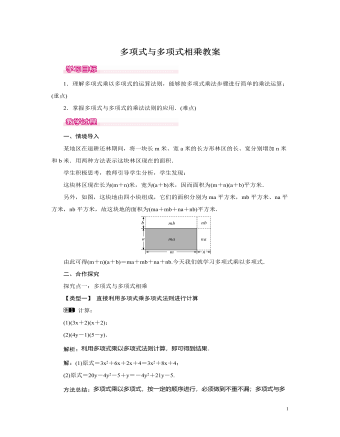
北师大初中七年级数学下册多项式与多项式相乘教案
解:(ax2+bx+1)(3x-2)=3ax3-2ax2+3bx2-2bx+3x-2.∵积不含x2项,也不含x项,∴-2a+3b=0,-2b+3=0,解得b=32,a=94,∴系数a、b的值分别是94,32.方法总结:解决此类问题首先要利用多项式乘法法则计算出展开式,合并同类项后,再根据不含某一项,可得这一项系数等于零,再列出方程解答.三、板书设计1.多项式与多项式的乘法法则:多项式和多项式相乘,先用一个多项式的每一项与另一个多项式的每一项相乘,再把所得的积相加.2.多项式与多项式乘法的应用本节知识的综合性较强,要求学生熟练掌握前面所学的单项式与单项式相乘及单项式与多项式相乘的知识,同时为了让学生理解并掌握多项式与多项式相乘的法则,教学中一定要精讲精练,让学生从练习中再次体会法则的内容,为以后的学习奠定基础

北师大初中九年级数学下册二次函数与一元二次方程1教案
解:(1)设第一次落地时,抛物线的表达式为y=a(x-6)2+4,由已知:当x=0时,y=1,即1=36a+4,所以a=-112.所以函数表达式为y=-112(x-6)2+4或y=-112x2+x+1;(2)令y=0,则-112(x-6)2+4=0,所以(x-6)2=48,所以x1=43+6≈13,x2=-43+6<0(舍去).所以足球第一次落地距守门员约13米;(3)如图,第二次足球弹出后的距离为CD,根据题意:CD=EF(即相当于将抛物线AEMFC向下平移了2个单位).所以2=-112(x-6)2+4,解得x1=6-26,x2=6+26,所以CD=|x1-x2|=46≈10.所以BD=13-6+10=17(米).方法总结:解决此类问题的关键是先进行数学建模,将实际问题中的条件转化为数学问题中的条件.常有两个步骤:(1)根据题意得出二次函数的关系式,将实际问题转化为纯数学问题;(2)应用有关函数的性质作答.
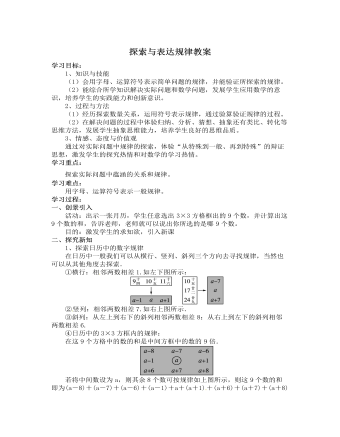
北师大初中七年级数学上册探索与表达规律教案2
学习目标:1、知识与技能(1)会用字母、运算符号表示简单问题的规律,并能验证所探索的规律。(2)能综合所学知识解决实际问题和数学问题,发展学生应用数学的意识,培养学生的实践能力和创新意识。2、过程与方法(1)经历探索数量关系,运用符号表示规律,通过验算验证规律的过程。(2)在解决问题的过程中体验归纳、分析、猜想、抽象还有类比、转化等思维方法,发展学生抽象思维能力,培养学生良好的思维品质。3、情感、态度与价值观通过对实际问题中规律的探索,体验“从特殊到一般、再到特殊”的辩证思想,激发学生的探究热情和对数学的学习热情。学习重点:探索实际问题中蕴涵的关系和规律。学习难点:用字母、运算符号表示一般规律。学习过程:一、创景引入活动:出示一张月历,学生任意选出3×3方格框出的9个数,并计算出这9个数的和,告诉老师,老师就可以说出你所选的是哪9个数。

北师大初中七年级数学上册探索与表达规律教案1
(1)依照此规律,第20个图形共有几个五角星?(2)摆成第n个图形需要几个五角星?(3)摆成第2015个图形需要几个五角星?解析:通过观察已知图形可得:每个图形都比其前一个图形多3个五角星,根据此规律即可解答.解:(1)根据题意得,第1个图中,五角星有3个(3×1);第2个图中,五角星有6个(3×2);第3个图中,五角星有9个(3×3);第4个图中,五角星有12个(3×4);∴第n个图中有五角星3n个.∴第20个图中五角星有3×20=60个.(2)摆成第n个图形需要五角星3n个.(3)摆成第2015个图形需要6045个五角星.方法总结:此题首先要结合图形具体数出几个值,注意由特殊到一般的分析方法.此题的规律为摆成第n个图形需要3n个五角星.三、板书设计教学过程中,强调学生自主探索和合作交流,经历观察、操作、验证、归纳、分析、猜想、抽象、积累、类比、转化等思维过程,从中获得数学知识与技能,体验教学活动的方法,同时升华学生的情感态度和价值观.
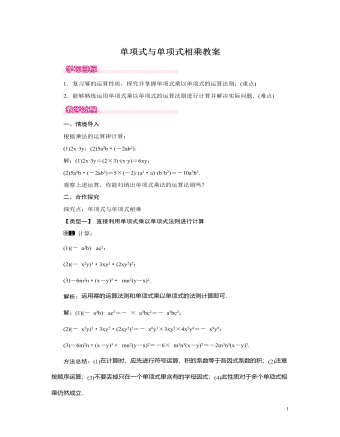
北师大初中七年级数学下册单项式与单项式相乘教案
解析:先求出长方形的面积,再求出绿化的面积,两者相减即可求出剩下的面积.解:长方形的面积是xym2,绿化的面积是35x×34y=920xy(m2),则剩下的面积是xy-920xy=1120xy(m2).方法总结:掌握长方形的面积公式和单项式乘单项式法则是解题的关键.三、板书设计1.单项式乘以单项式的运算法则:单项式相乘,把系数、同底数幂分别相乘,作为积的因式;对于只在一个单项式里面含有的字母,则连同它的指数作为积的一个因式.2.单项式乘以单项式的应用本课时的重点是让学生理解单项式的乘法法则并能熟练应用.要求学生在乘法的运算律以及幂的运算律的基础上进行探究.教师在课堂上应该处于引导位置,鼓励学生“试一试”,学生通过动手操作,能够更为直接的理解和应用该知识点

北师大初中数学八年级上册二元一次方程与一次函数1教案
由②得y=23x+23.在同一直角坐标系中分别作出一次函数y=3x-4和y=23x+23的图象.如右图,由图可知,它们的图象的交点坐标为(2,2).所以方程组3x-y=4,2x-3y=-2的解是x=2,y=2.方法总结:用画图象的方法可以直观地获得问题的结果,但不是很准确.三、板书设计1.二元一次方程组的解是对应的两条直线的交点坐标;2.用图象法解二元一次方程组的步骤:(1)变形:把两个方程化为一次函数的形式;(2)作图:在同一坐标系中作出两个函数的图象;(3)观察图象,找出交点的坐标;(4)写出方程组的解.通过引导学生自主学习探索,进一步揭示了二元一次方程和函数图象之间的对应关系,很自然的得到二元一次方程组的解与两条直线的交点之间的对应关系.进一步培养了学生数形结合的意识,充分提高学生数形结合的能力,使学生在自主探索中学会不同数学知识间可以互相转化的数学思想和方法.
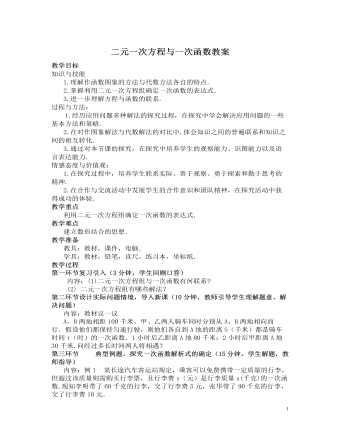
北师大初中数学八年级上册二元一次方程与一次函数2教案
2. 在弹性限度内,弹簧的长度y(厘米)是所挂物体质量x(千克)的一次函数.当所挂物体的质量为1千克时弹簧长15厘米;当所挂物体的质量为3千克时,弹簧长16厘米.写出y与x之间的函数关系式,并求当所挂物体的质量为4千克时弹簧的长度.答案: 当x=4是,y= 3. 教材例2的再探索:我边防局接到情报,近海处有一可疑船只A正向公海方向行驶.边防局迅速派出快艇B追赶,如图所示, , 分别表示两船相对于海岸的距离s(海里)与追赶时间t(分)之间的关系.当时间t等于多少分钟时,我边防快艇B能够追赶上A。答案:直线 的解析式: ,直线 的解析式: 15分钟第五环节课堂小结(2分钟,教师引导学生总结)内容:一、函数与方程之间的关系.二、在解决实际问题时从不同角度思考问题,就会得到不一样的方法,从而拓展自己的思维.三、掌握利用二元一次方程组求一次函数表达式的一般步骤:1.用含字母的系数设出一次函数的表达式: ;2.将已知条件代入上述表达式中得k,b的二元一次方程组;3.解这个二元一次方程组得k,b,进而得到一次函数的表达式.

